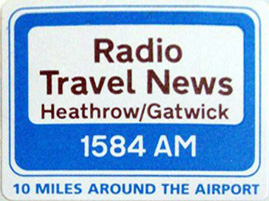Introduction
In this report I will talk about the focus of a radio station of my choice and all the specific details about my chosen radio station and how it functioned.
Chosen Station
The radio station I chose to write this report about is the Airport Information Radio, AIR for short. The Airport Information Radio began broadcasting on the 25th June 1990 with live presentation from 5am-11pm 7 days a week. The service reached motorists within 10-12 miles from either London Heathrow or London Gatwick Airport; this means that it was a local station because it only reached people nearby the airports and was not a national radio station that spanned the United Kingdom. However, outside of the live presentation was a pre-recorded service with basic airport information. AIR was distributed by AM with a frequency of 1584 kHz. It did not have a sister station however the Heathrow service was originally a separate operation. Airport Information Radio was owned by Mercury Radio
Focus
The main focus of AIR was to inform. The AIR informed people about any relevant news about London Heathrow and London Gatwick airport if they were close enough to the airports. It was not a station that had the purpose to entertain because it was purely an informative station to help people be knowledgeable about the airports or assist them by informing them about any news they should know about the airports. What is likely to be discussed on the station is informative conversations about both the airports and it is unlikely that anything else will be featured on the station as the station exists solely for informing the public about the status of London Heathrow and London Gatwick airport. As stated previously, the Airport Information Radio did not have a sister station, however the Heathrow service was originally a separate station to the AIR therefore before they merged together the Heathrow service would've discussed the news or any status updates about London Heathrow Airport but not about London Gatwick airport.
Target Audience
Due to Airport Information Radio being such a niche radio station, unfortunately there is no available information about the listening figures; the AIR stopped operating in 1996 therefore there is no listening figures or any other statistics on the internet. However, Airport Information Radio was a part of Mercury Radio and there is listening figures ands statistics of Mercury Radio available, in September 2009 people had listened to Mercury Radio for 541 hours.
The target audience for the Airport Information Radio is quite unique compared to other radio stations because it does not factor in demographics or psychometric profiles like other radio stations do. Because the AIR is purely for informing the public, the target audience doesn't factor in gender, ethnicity, sexuality and instead the target audience is for anyone who is nearby the airports or people who have a flight booked and need information about the airport so they aware of any relevant information they need to know. The only demographic that is relevant to the target audience of the AIR is age because it is unlikely that people under the age of 18 will be interested in being informed of information about the Airports. If anyone under 18 is going to one of the airports it is very likely they are going with their parents, therefore it is most likely their parents who will tune into the radio station to be informed. The station did not do much to attract its audience because it is an informative station and the company is aware that the people who need to use the station's services will listen in when they want to, however they did have road signs around the airport to inform people about the existence of the radio station incase they weren't aware.
The original advertisers on the Airport Information Radio included: The Body Shop, Tie Rack, WHSmith, Harrods, Alamo Rent a Car, Burger King, The European News and Sterling Hotels. The only Airline that purchased airtime advertisements on the AIR is South African Airways. The ad rates for 30 seconds were £36 and the ad
rates for 60 seconds were £65.
This is a road sign that informed drivers that were near the airports about the radio station so they could listen if they wanted to find out information or news about the airports.
Show
& Presenters
The shows included on the Airport Information Radio
were flight news, road news, terminal information and currency exchange rates. These shows would inform the viewers about any delayed or cancelled flights, any accidents on nearby roads and information about the different exchange rates for different currencies around the world like Euros or American Dollars. Presenters on the Airport Information Radio were Rick Easter, Peter Stuart, and
Dave Heskitt. Additionally, the pre-recorded announcements were voiced by Tony
Myatt, John Scragg and Danny Pike. From the information available on the internet, there is no evidence of the content varying on the radio show depending on the presenter. However, you could argue that the content did vary depending on the presenters become some presented the show live while others created recorded shows.
Bibliography
“Radio Mercury.” Localradioarchive.co.uk, localradioarchive.co.uk/radio_mercury/airport_information_radio.php. Accessed 15 Mar. 2024.
“RAJAR.” Rajar.co.uk, 2019, www.rajar.co.uk/.


Comments
Post a Comment